It is snowing in London, and just cold enough that a slight dusting has stuck to side streets and car roofs. In Prague the snow is coming down thick, and pictures of my old neighbourhood in the snow are making me a bit teary and resentful of all the travelling I cannot do. Snow in Europe shouldn’t be particularly newsworthy, but in a post climate change world these things are remarkable. Sitting as I am, in a medieval city (well, technically in a village just outside of the city, but still), and being who I am as a person, I have been thinking about winter and weather in the medieval period, and how its changes influenced society writ large.
The thing is, if we are talking about winter in the medieval period, there isn’t just one generalised story about what that means. This is because we have at least two distinct eras of climate in the medieval period. There may be more, but famously our documentary evidence of the early medieval period is, well, sketchy, leading us to use particular terms that were then ruined by basics who watched Monty Python and the Holy Grail and thought it was a documentary. Anyway! We do start having pretty good records from about the tenth century onwards, and it tells us a little something about the weather in the high medieval period.
While we tend to associate the nebulous European past with snowy winters, it turns out that from about 900-1300 that not the case overall. During that period the European peninsula was experiencing something which we generally refer to as “the medieval warm period”. Overall it seems that Europe’s temperatures were actually pretty warm, as the area experienced a “climatic optimum”, and were both fairly stable, and slightly warm. Warmer temperatures allowed for some pretty cool things. First, larger harvests helped to encourage a population boom as more food meant more mouths could be fed. Second, with more people around there was then both a desire to find more arable land, and a workforce able of undertaking the work necessary to make that happen.
The population began to expand into areas previously considered uninhabitable. It was during this time that the lowlands (AKA what we now call the Netherlands and Belgium) were drained, and new land arose from out of the swamps along the North Sea coast. The new land was kinda salty since it had just emerged from brackish marshes, and all of that, which meant that it wasn’t necessarily optimum for growing crops at first. However, what it was absolutely set up for was grazing a lot of sheep, as sheep quite famously DGAF. Thing about sheep is that they are covered in what during the medieval period was one of the most important trade commodities – wool. In a world where there were suddenly surplus crops being grown, lowland communities on newly reclaimed land were able to set up not around subsistence farming, but around cultivating and refining the wool that they were able to grow. The great cities of the lowlands – Ghent, Bruges, Ypres, Antwerp, and Amsterdam (just to name a few!) focused up on moving wool from the fields via a series of intricate canals, which were pretty easy to establish with such a low water table, into the cities where they were refined into cloth and sold on. This gave the cities money which they could exchange for goods and services. Like food. Which was grown in non-salty fields elsewhere. They would remain absolute economic powerhouses well into the early modern period, set up as they were to distribute an in-demand and sustainable commodity.
While the lowlands are a particular case, in general the temperate climate of the high medieval period supported the increasing urbanization of the continent, writ large. Suddenly it was feasible to have a few thousand people living somewhere like Paris, Munich, or Prague because peasants were producing enough food to feed those who were not farming. Moreover, the increase in commerce encouraged a shift over from a bartering economy to a cash-based one. In some cases this actually helped peasants out. It was common, for example, during this period for landlords to shift from demanding a work tax (called a corvée in Francophone lands, or a robota in the Czech lands) from their serfs to asking for cash. This was still bad and immoral. However, it also freed the serfs up a bit to pursue the cultivation of cash crops, and spend a bit less time toiling directly for their landlords. (Must be nice.)
All of this is, of course, a massive oversimplification of the complex process of population expansion and urbanization in the medieval period. However it is undeniable that the warmer temperatures that the continent enjoyed directly influenced population growth and expansion, and meant that suddenly the peninsula was more urbanized than it had ever been before. Wank off to those slave enthusiasts the Romans all you want, but those MFers were never able to set a city up on the Baltic coast. Medieval Europeans could and did.
While the social impacts of the climate were long-ranging and intricate, they are also of interest because of the day to day ways they influenced people’s lives and the way they thought about their environment and seasons. We can see glimpses of this in my on-going obsession The Labours of the Months, an art motif that shows the various jobs that were undertaken throughout the year. When we look at images of December, especially in the high medieval period, we are not treated to scenes of a winter wonderland. Instead we see peasants engaging in their standard labours – bread baking and pig slaughtering – , as well as nobles in theirs – hunting boar – in barren landscapes. It certainly looks like winter, but the sort of dull leaden December those peasants experienced is rather akin to what I am used to seeing here now.
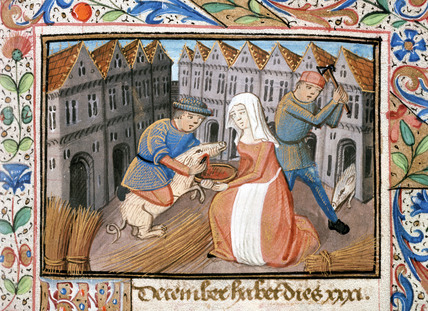


The idea that the Winter has become really quite cold is usually reserved for the month of February. Here inside scenes focus on warming oneself by the fire, while outside scenes often show us the snow that has finally fallen.
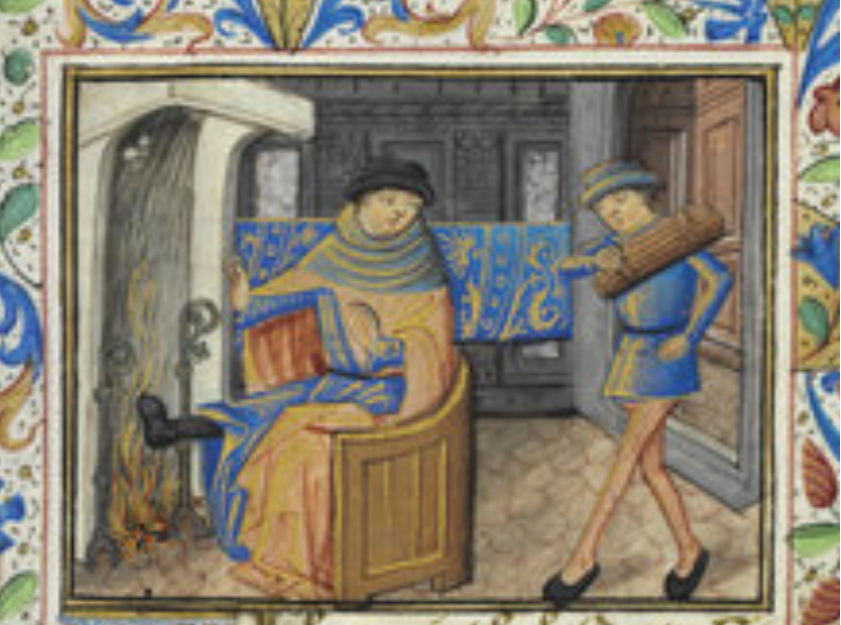
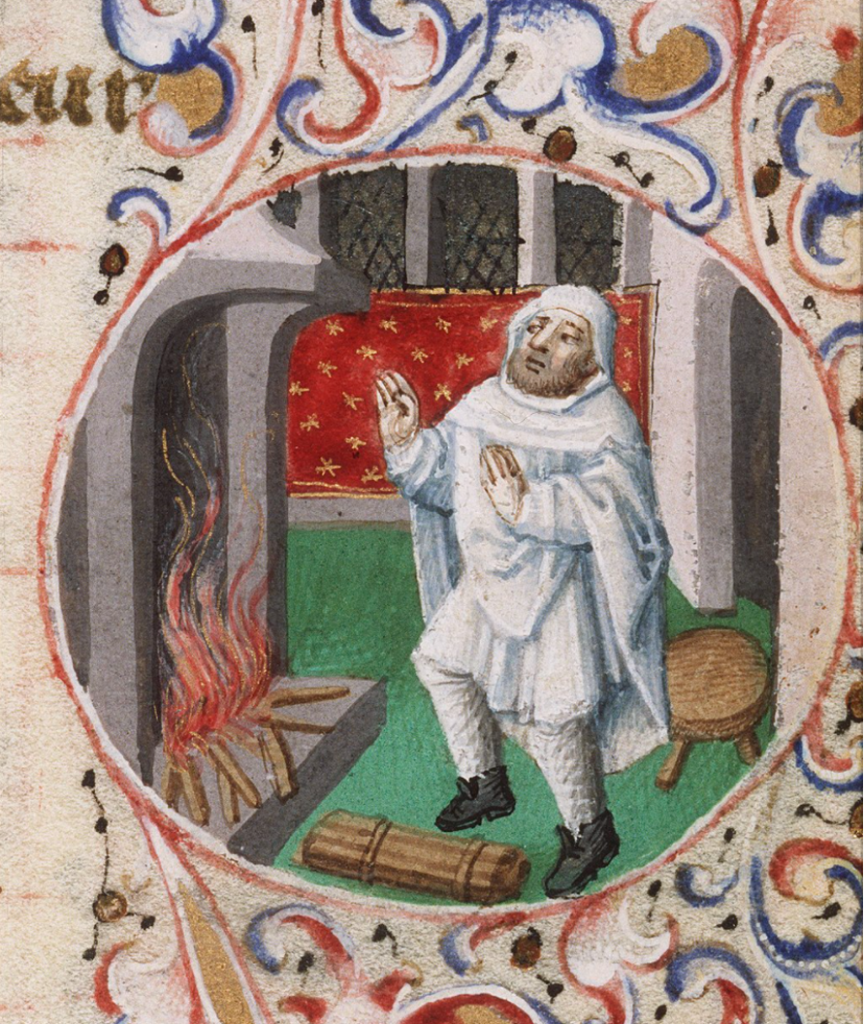
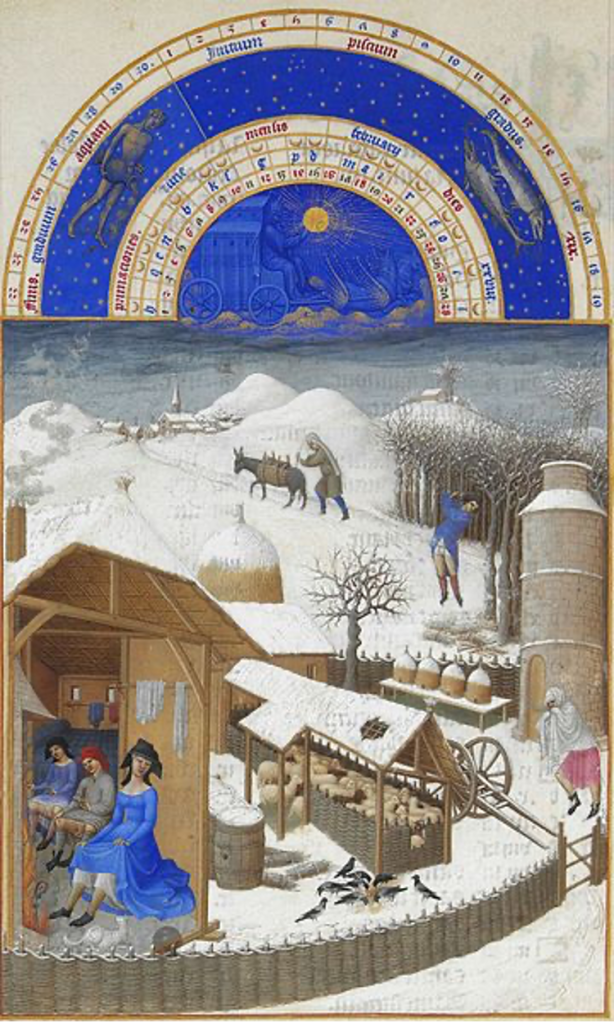
Overall, then, most medieval Europeans would nod along with my current experience of snow, in that it is here in February and emphatically was not back at Christmas.
As you will have noted for the date range of the medieval warm period, this state of affairs eventually collapsed. There was already trouble in the fourteenth century, where several years of heavy rains and extra cold weather from 1315-1317 lead to the Great Famine, a massively destabalising event which lead to starvation and increased mortality from Russia down to Italy. While this was a discrete incident that we can pin to a specific date range, from the fourteenth century, slowly but surely, temperatures began to fall. You’ll note that all of the labours of the year I showed you above are from the fifteenth century. By the sixteenth century, December scenes began to change. While the labours remained the same, the circumstances that they were undertaken has altered, and snow was very much associated with pig slaughter.

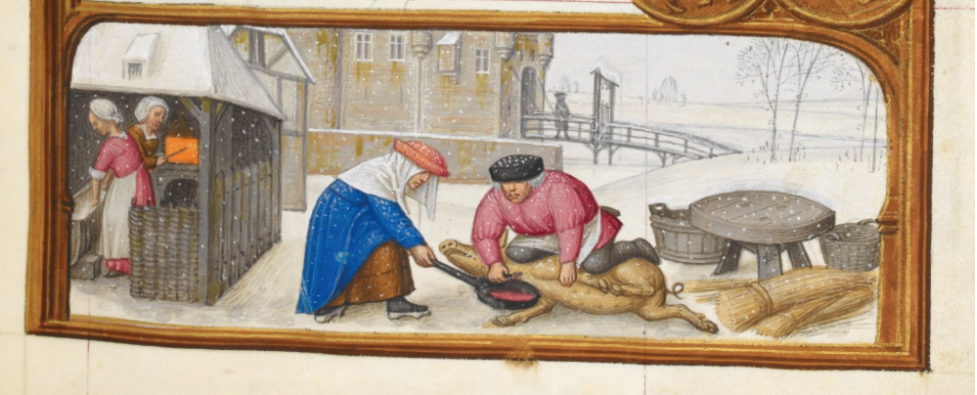

What this shift hints at is Europe’s descent into the Little Ice Age, when from the sixteenth to the nineteenth centuries the temperature decisively dropped continent and world wide. There are several theories as to why this drop off occurred, ranging from solar radiation, to exploding volcanoes, but one way or another, for a three hundred year period or more, suddenly stuff was a lot chillier across the continent, leading us to our ideas of snowy European Christmases. They very certainly were a thing, but really much more of an early modern phenomenon, and not one that we see echoed for most of the medieval period.
While there was a decisive shift towards colder temperatures in the early modern period, and the medieval inhabitants of my village probably also experienced a snow-free December, I want to emphasise that my excitement over a day of weak-sauce snow would very much have been alien to them. Even if snow in December was rare for most of the medieval period, it sure as hell wasn’t in February. Even further, this is the first snowfall that has stuck in London for at the very least seven years. That is odd, and it is as a direct result of the climate change that we are all currently experiencing. It did used to snow in London during the winter, even in just the time that I have lived here. Now that experience is rare enough that it prompts me to spend my morning waxing rhapsodic about snow and the European experience at you. This is very bad.
Indeed, lest you think that we have simply reached back to the equilibrium of the medieval period, I have a very depressing chart for you showing that we have very much overtaken the nice medieval temperatures quite dramatically.
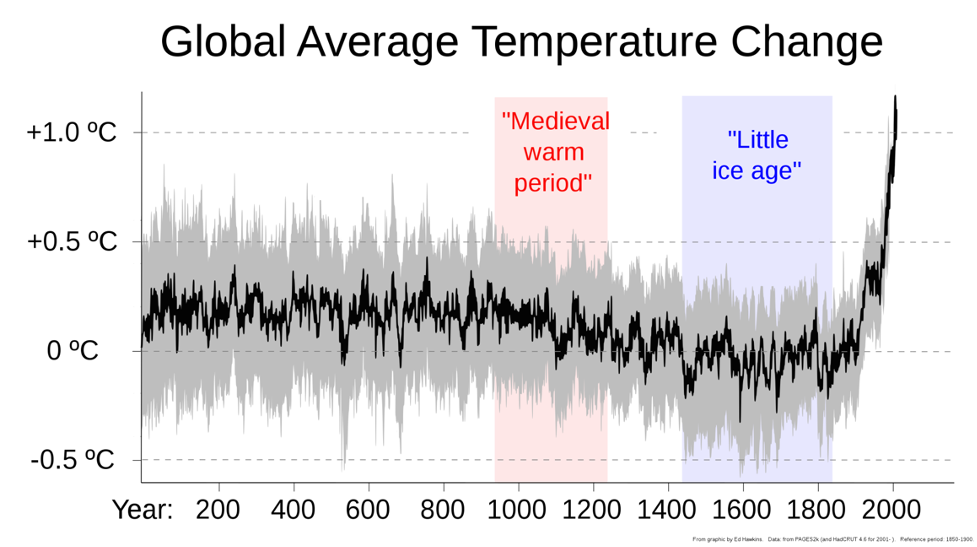
I don’t have a snappy way of making this feel less dreadful. A nice way to be connected with our past would be to know that we are reliably experiencing the same meteorological conditions as our ancestors did. That is very clearly not the case. We are now changing the environment around us at an unprecedented rate, and unlike the Northern Europeans who were able to build a sustainable new environment which benefited their community as a whole, the incidental damage we are doing to our world in order to create surplus value for a couple of extremely wealthy people serves no greater good. We are sleepwalking away from the world that existed for thousands of years, with little thought to what that means to our lives and society. What I hope you will take away from this post is that changes in temperature have the ability to precipitate change for the good, but they can also lead to massive problems. It would be nice if we could consider that, and maybe do something about climate change, if only because I would like to see some snow once in a while.
If you enjoyed this, please consider contributing to my patreon. If not, that is chill too!
For more on the seasons in the medieval period, see:
On the Lusty month of May
On Michaelmas
On the Medieval secret to a balling Christmas for once

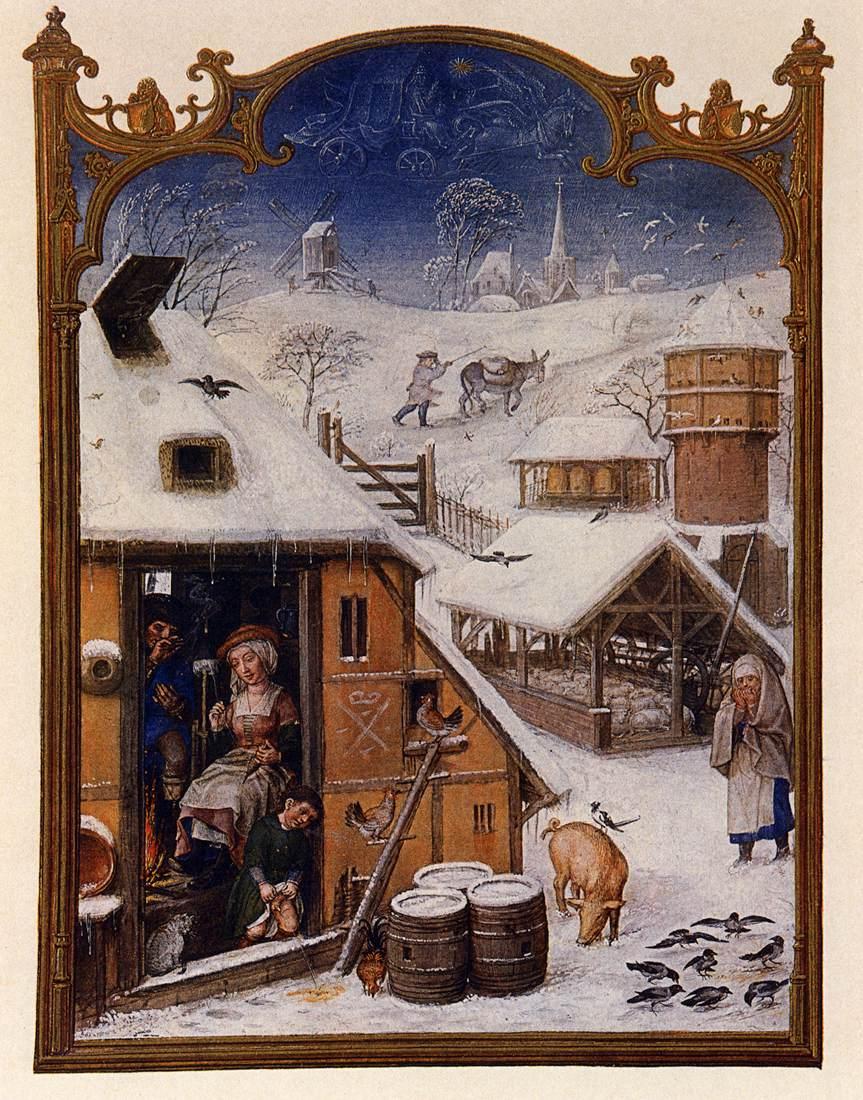
Enjoyable and instructive as usual–thanks. (“Basics” as a noun to mean “blockheads”is new to me but lends a whole new flavor to the slogan “back to basics.”) Your mention of the shift from corvée to money rent reminds me (a NON-scholar, I hasten to add) of the things I read from the Transition Debate. Along the way I learned that the various kinds of non-cash obligations of tenants were grouped under the term “banalités” which is nice. Was that in the contribution by the Portuguese Communist Alvaro Cunhal? Maybe… That (NON-scholarly!) reading was a while ago–prolly 30 years or so–but I’d really like to read your thoughts on that debate. Well, your blog could be characterized as an extended comment on, or contribution to, that debate, but if you have specific observations about Maurice Dobb or whoever, I’d be an eager listener. (Cunhal wrote an interesting article about the Praça da Jorna “shape-up” system of hiring day laborers on the big latifundia in southern Portugal.) And if you have any thoughts about Ellen Meiksins Wood in particular, I’d love to read those too. I found her answer to “why England?” persuasive, but as usual, I’m diffident about evaluating material because of being NOT a scholar.
LikeLike
Reading this from the perspective of just having survived (literally) a winter storm with 0F temperatures in Texas (isolated rural location; no power or heat (and no real food) for 85 hours; no water for 125 hours), the devastating consequences of global climate change are dangerously real right now, not just in the near future. I know I would definitely like just ‘normal’ snow for Texas myself, but fear we actually passed the tipping point long ago.
LikeLike
I am so sorry that you have had to deal with all of that. It is genuinely terrifying seeing what everyone in Texas has gone through and I am so incredibly worried about our future. Thinking of you.
LikeLiked by 1 person